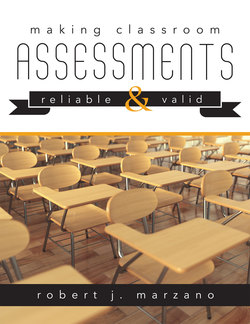Читать книгу Making Classroom Assessments Reliable and Valid - Robert J Marzano - Страница 4
На сайте Литреса книга снята с продажи.
ОглавлениеTable of Contents
About the Author
Introduction
THE ROLE OF CLASSROOM ASSESSMENT
The Curious History of Large-Scale Assessments
The Place of Classroom Assessment
Reliability and Validity at the Heart of the Matter
The Need for New Paradigms
The Large-Scale Assessment Paradigm for Reliability
The Equation for a Single Score
The Reliability Coefficient
The New CA Paradigm for Reliability
The Large-Scale Assessment Paradigm for Validity
The New CA Paradigm for Validity
What to Expect in This Book
Chapter 1
DISCUSSING THE CLASSROOM ASSESSMENT PARADIGM FOR VALIDITY
The Instrumental Perspective
The Argument-Based Perspective
Standards as the Basis of CA Validity
The Standards Movement
The Problem With Standards
Dimensionality
Measurement Topics and Proficiency Scales
The Rise of Learning Progressions
The Structure of Proficiency Scales
The School’s Role in Criterion-Related Validity
The Nature of Parallel Assessments
The Measurement Process
Summary
Chapter 2
DESIGNING AND SCORING PARALLEL ASSESSMENTS
Traditional Tests
Designing Selected-Response Items
Designing Short Constructed-Response Items
Scoring Assessments That Use Selected-Response and Short Constructed-Response Items
Essays
Performance Tasks, Demonstrations, and Presentations
Portfolios
Probing Discussions
Student Self-Assessments
Assessments That Cover One Level of a Proficiency Scale
Voting Techniques
Observations
Student-Generated Assessments
The Complete Measurement Process
Assessment Planning
Differentiated Assessments
Summary
Chapter 3
DISCUSSING THE CA PARADIGM FOR RELIABILITY
Discussing the Traditional View of Reliability
Foundations of the Traditional Concept of Reliability
The Concept of Error Score
The Concept of True Score
The Correlation Coefficient and the Reliability Coefficient
The Conceptual Formula for Reliability
The Reliability Determination Using a Single Test
The Achilles Heel of the Reliability Coefficient
Estimating True Scores Using Mathematical Models
The Linear Trend Line
The Curvilinear Trend Line
The Average Trend Line
Model Reconciliation
Model of Best Fit
Using Technology
Discussing the Implications for Formative and Summative Scores
Using Instructional Feedback
Employing the Method of Mounting Evidence
Considering the Issue of Scales
Proficiency Scales as Inherently Ordinal
Proficiency Scales That Are Internally Consistent
The Strong Statistics Theory
Summary
Chapter 4
MEASURING GROWTH FOR GROUPS OF STUDENTS
Measuring Growth
Linear Growth Score
The Curvilinear Growth Score
The Difference Score
Reconciling the Three Reliabilities
Using Technology to Help Teachers
Summary
Chapter 5
TRANSFORMING THE SYSTEM USING THE NEW CLASSROOM ASSESSMENT PARADIGMS
Transforming Report Cards
Weighted and Unweighted Averages
The Median and the Mode
The Conjunctive Approach
A Supplemental Measurement Topic
The Practice of Allowing Students to Increase Their Scores
Transforming Teacher Evaluations
Summary
Appendix
TECHNICAL NOTES
Technical Note I.1: Confidence Intervals
Technical Note 3.1: Linear Trend Line
Technical Note 3.2: Curvilinear Trend Line
Technical Note 3.3: Trend Line for the Average
Technical Note 3.4: The Method of Mounting Evidence
Technical Note 4.1: Reliability of Linear Growth Scores
Technical Note 4.2: Reliability of Curvilinear Growth Scores
Technical Note 4.3: Reliability of Difference Scores
References and Resources
Index
